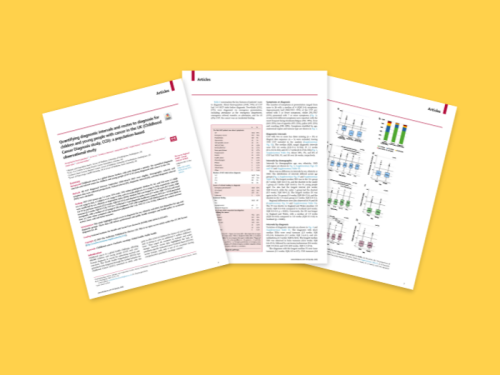The World Health Organization recognises childhood cancer as a major global health challenge, with early diagnosis being essential for improving survival and long-term outcome. This nationwide study has provided new insights into how long it takes for children and young people (CYP) in the UK to be diagnosed with cancer and the journey they go through to get a diagnosis. The research found that while the time to diagnosis varies depending on age and type of cancer, it is not influenced by gender, ethnicity, or the family’s socioeconomic status. These findings will set the benchmark and help shape public health strategies to improve early diagnosis and ensure all children and young people receive timely care.
About the study
The Childhood Cancer Diagnosis Study recruited 1,957 children and young people (aged 0-18 years) who were diagnosed with cancer between September 2020 and March 2023. All patients were treated at one of the 20 CCLG Principal Treatment Centres - specialist hospitals in England, Scotland, Wales, and Northern Ireland that provide expert care for children and young people with cancer. Just over half of the participants were male (54%). Most of the participants lived in England (87%), and the majority were from White ethnic backgrounds (78%).
Time to diagnosis
The study looked at how long it took for a child or young person to be diagnosed with cancer after their first symptoms appeared. This time, called the total diagnostic interval, varied a lot. Some were diagnosed on the same day their symptoms started, while for others, it took years. The median time was 4.6 weeks, meaning that half of the CYP were diagnosed before 4.6 weeks and half took longer.
The time to diagnosis also varied depending on the patient's age and the type of cancer:
- Teenagers (15-18 years) had the longest time to diagnosis, with a median of 8.7 weeks, while infants under one year had a shorter median time of 3.7 weeks.
- Bone tumours took the longest to diagnose, with a median time of 12.6 weeks, while kidney tumours were diagnosed the fastest, with a median of 2.3 weeks.
- Importantly, the study found no difference in diagnostic times by sex, ethnicity, or socioeconomic background, suggesting that everyone in the UK has broadly equal access to services that can diagnose cancer.
Pathways to diagnosis
The researchers also studied the number of visits to a healthcare professional before a diagnosis was made, and patients’ pathways to diagnosis:
- 74% of CYP had one to three healthcare visits.
- 67% were diagnosed as an emergency1.
- The majority of patients first saw a GP or an emergency doctor, and only 5% were diagnosed by a paediatrician.
- A total of 63 different symptoms were reported. About half of the CYP presented with three or fewer symptoms, whilst 15% presented with seven or more symptoms.
- Patients with Langerhans Cell Histiocytosis, bone tumours, soft tissue sarcomas, and brain tumours were more likely to have had four or more medical visits before being diagnosed.
These findings highlight how cancer symptoms in children and young people can often be non-specific. This can make diagnosis difficult, as many of these symptoms also occur in more common childhood illnesses. Because they are not unique to cancer, it can be hard to recognise when something more serious is going on.
What do these findings mean?
A longer time to diagnosis can lead to more serious illness at the time of diagnosis, more intense treatment, and greater distress for patients and families. Understanding which groups tend to wait longer can help identify ways to improve.
This study highlights that, while different demographic groups have equal access to diagnostic services, some children, particularly teenagers and those with certain types of cancer, experience longer times to diagnosis. These findings will help raise awareness among both the public and healthcare professionals, ensuring more CYPs receive a faster diagnosis.
Looking forward
The results will help to shape the Child Cancer Smart campaign organised by CCLG: The Children & Young People’s Cancer Association, which aims to speed up the diagnosis and raise public and professional awareness. The data will also contribute to England’s upcoming National Cancer Plan, helping to strengthen referral routes and ensure that all children and young people receive a timely diagnosis.
A planned five-year follow-up will also start soon to examine how diagnostic intervals affect outcomes such as relapse, survival, and long-term health, helping to determine whether faster diagnosis leads to better results.
[1] Emergency presentation: an emergency route via A&E, including emergency GP referral, emergency consultant outpatient referral, emergency transfer, emergency admission or attendance
Read the full study
Read the full published Childhood Cancer Diagnosis study in the Lancet
Download the study
Download the Child Cancer Diagnosis study as a PDF.

